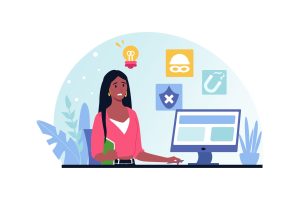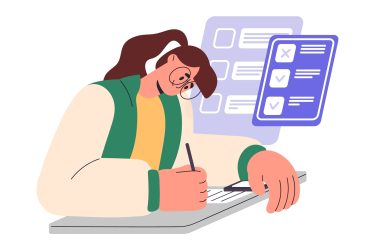How to Choose a Plagiarism Checker: A Comprehensive Guide
23.3% of students, surveyed in 2020, say they cheat on exams. The research itself is regularly updated and, for now, it highlights that 58% of students from 24 high schools across the U.S. admitted to plagiarism. Just a gentle reminder: these numbers cover only those who confirmed some form of cheating.
With studies going online after the COVID-19 outbreak, some schools and universities started commissioning proctors and specialized software for online exams. As for writing assignments, educators mostly use plagiarism checkers to verify if the paper belongs to the student that handed it in.
But how to select one? Because picking, let’s say, fruits at the supermarket is a no-brainer. Choosing a plagiarism checker can be a backbreaker, on the contrary. With lots of tools available and even more emerging, it’s so easy to get confused. That’s why we’re here to help you out.
Check what makes a top-notch plagiarism checker and what things you should pay attention to when choosing one for your high school, college, or university.
7 Must-Have Features of the Good Plagiarism Checker
#1. High Accuracy
The core feature of any plagiarism detector is to ensure as precise text analysis as possible.
In a perfect world, it should scan online sources, like publications (like blogs, articles, different websites, etc.), Internet archives, students’ papers, diverse scientific resources, and so on. With academic writing, it’s even better if the tool can compare a document against other papers that were previously submitted.
Tip: When choosing a plagiarism checker for your school, college, or university, try to find out which database it’s using. The more different content types it includes, the more reliable results you’ll get.
#2. Detection of All Plagiarism Types
Another crucial thing is spotting different kinds of plagiarism in the papers. And by different kinds we mean:
- Exact matches, when text fully coincides with other documents.
- Synonyms that are used to replace original wording.
- Switches of word order and/or sentence structure.
#3. Authorship Verification
Or should we have started with this one?
Paraphrasing is another common issue for academic integrity. It’s difficult to find out, as a student can change word forms, tenses, voices, and so on.
With the rise of AI writing platforms, it becomes even harder to discover whether it’s a human-generated text at all. Such solutions as ChatGPT, for instance, can easily compile quite a decent essay in no time.
This is why preventing GPT-3 cheating is possible only with advanced paraphrasing checkers. The latter should not just look up for similarities in texts, but check if the style of the current document matches previous works of the same author.
#4. Easy-To-Read Reports
The hidden catch is here: they should be both insightful and simple for understanding.
Some basic components of a plagiarism report are:
- Highlights of the possibly plagiarized parts
- Links to the sources that match the text
- Percentage of plagiarized and/or original content
The possibility to export and share the reports in multiple options is optional but nice to have, too.
#5. Extensive Support
This is about your smooth experience in case anything goes wrong. And since no one’s perfect, service providers are no exception. So consider the support team’s work hours, responsiveness, and how good they are at solving your problems.
The 3 basic things that define a flawless support team are:
- 24/7/365 availability. These are not just numbers, it’s about readiness to help round-the-clock. It’s especially important if the company behind a plagiarism check provides services in different countries. You wouldn’t want to wait for an answer to a critical issue for hours (not mentioning days), would you?
- Helpfulness. If not, agility. We mean, some issues can’t be resolved in a few clicks. But there might be other options, and a great supporter will offer them instead. The can-do approach does miracles.
- Openness to feedback. You can call it “the ability to hear, not just listen.” If the team (and the product it works on) is ready to collect your ideas on what could be improved, it’s great. Thus, they’ll be able not just to resolve your issues, but also to add the requested functionality and enhance the tool for even more convenience.
Basically, all those things are signs that this particular provider truly cares.
#6. Data Protection
Remember the #1 feature? Yes, an internal database is of no less importance than scanning online sources. But you’d better check if the tool of your choice doesn’t publish the papers it scans online. For instance, here at PlagiarismCheck.org, we create a separate space for each educational institution to compare the submitted works against one another.
Also, if you need to sign up/log in to perform the scan, you’ll most likely have to provide your name, email, and other personal details.
To make sure this information doesn’t get into the wrong hands, ask how this particular vendor protects sensitive data. Also, you can examine whether they comply with such industry-specific regulations as the GDPR.
#7. Little to No Downtimes
Finally, look out for services that have stable performance and won’t let you down during the scans. Sometimes, you can find it out only while actually using a plagiarism checker.
Overall, we recommend trying the plagiarism checker of your choice before purchasing it. This will help you figure out if it’s working well, suits your needs, and is worth your money.
To sum it up
We hope that by now, the only question you have is where to find those plagiarism checkers and how to compare them.
As for the first question, the answer is quite simple: search such tools on Google or professional forums. Also, if you attend diverse educational conferences, you can come across a few vendors there.
To help you with the other question, we’ve prepared a plagiarism checkers comparison table template for you. You can either download it and print out or copy to your Google sheets and edit it there.
If you’re still not sure how to make the final decision, get in touch—we’re always here to answer any of your questions. Or you can even get started comparing tools for plagiarism detection with our PlagiarismChecker.






